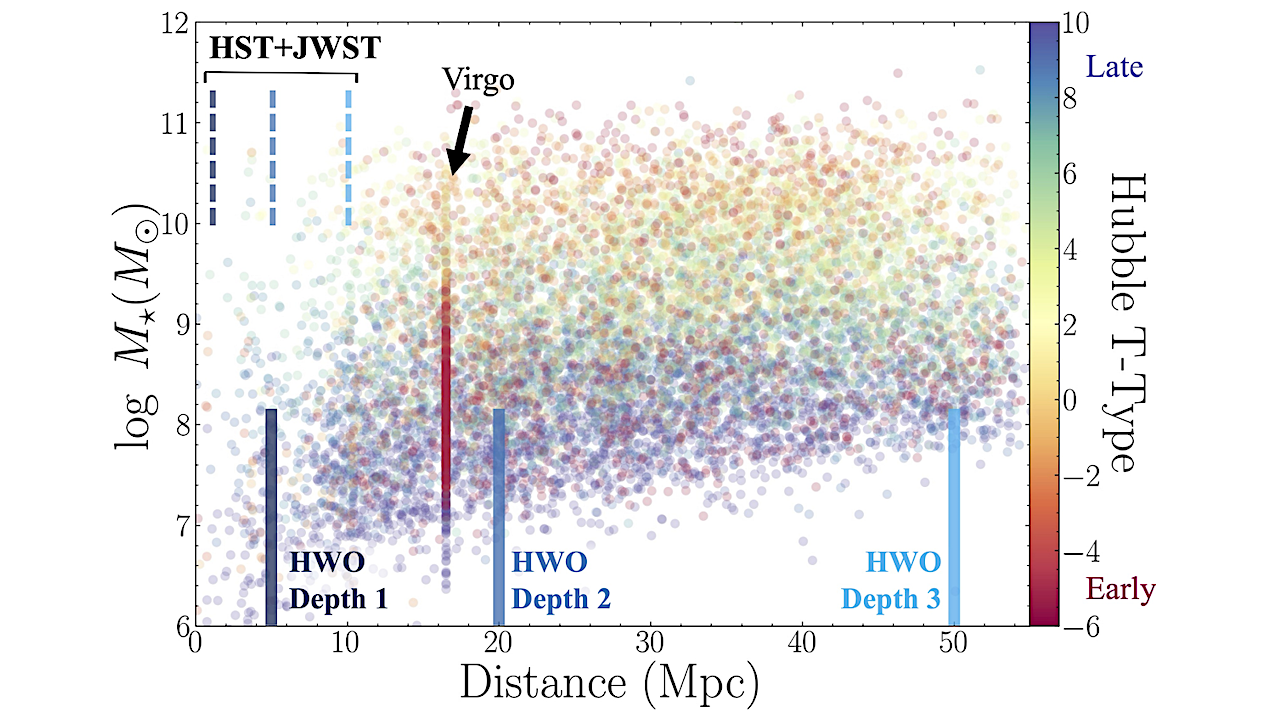Distance vs. Stellar Mass for over 15,000 known galaxies out to 50 Mpc (Ohlson et al. 2024). Galaxies are colorcoded by their Hubble “T” Type, with early type galaxies T < 0 and late-type galaxies T > 0. The three stellar luminosity depth limits – RGB, sub-Red Clump, and sub-oMSTO – are shown as lines, corresponding to the distances where they are achievable for massive galaxies, and color-coded according to Fig. 1. The distances for these 3 depths achievable with HST and JWST are shown as dashed lines, while those achievable with HWO are shown as solid lines. The increase in galaxy diversity accessible from JWST→HWO is striking. The color bimodality of galaxies (e.g., Baldry et al. 2004) is visible within HWO’s reach, as is the Virgo Cluster which is notable as a vertical line of enhanced density. — astro-ph.GA
The varied and dynamic evolutionary histories of galaxies give rise to the stunning diversity in their properties that we observe in the present-day universe.
HST, and now JWST, have pioneered the study of resolved individual stars in the Milky Way and other members of the Local Group, uncovering the drivers of their morphological, star formation, and chemical evolution. HWO will constitute a paradigm shift: introducing the ability to panchromatically resolve the main bodies of every galaxy in the Local Volume into their constituent stars.
In this science case, we summarize the breakthrough progress that HWO will advance in the field of galaxy evolution through resolved stellar populations.
HWO will transform our understanding of galaxies in three distance regimes: (1) in the nearest galaxies (∼5 Mpc), where it will resolve stars below the oldest Main Sequence Turnoff, enabling precision stellar astrophysics and star formation history (SFH) inferences to the earliest cosmic times; (2) in the greater Local Volume (∼20 Mpc), where it will resolve stars below the Red Clump, providing access to accurate SFHs for hundreds of galaxies, spanning the entire Hubble Sequence; and (3) out to cosmological volumes (∼50+ Mpc), providing access to the luminous stellar populations in thousands of galaxies, enabling unprecedented views of their morphology, stellar abundances, and dust content.
The principal technological requirement advanced by this science case is a camera with a resolution of ⩽0.015” that is diffraction-limited, and Nyquist-sampled (0.01” per pixel), to at least 550 nm − comparable to the High Definition Imager from the LUVOIR concept.
Adam Smercina, Tara Fetherolf, Eric W. Koch, Silvia Martocchia, Chris Mihos, Benjamin F. Williams
Comments: Evolution of the Elements SCDD, to be presented at HWO2025 and submitted to ASP following community comments. If interested in endorsing, or giving feedback and being included as a co-author, please use the form linked on the Community Science Case Portal (this link https://outerspace.stsci.edu/display/HWOCOMMUNITYSCI/HWO+Community+Science+Case+Portal)
Subjects: Astrophysics of Galaxies (astro-ph.GA)
Cite as: arXiv:2507.01960 [astro-ph.GA] (or arXiv:2507.01960v1 [astro-ph.GA] for this version)
https://doi.org/10.48550/arXiv.2507.01960
Focus to learn more
Submission history
From: Adam Smercina
[v1] Wed, 2 Jul 2025 17:59:54 UTC (12,254 KB)
https://arxiv.org/abs/2507.01960
Astrobiology, Astronomy,
